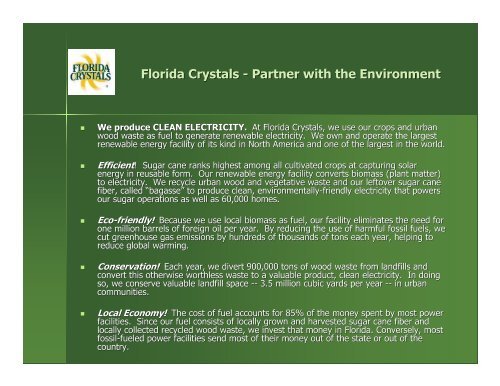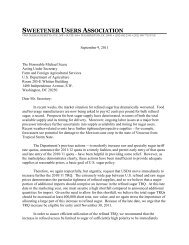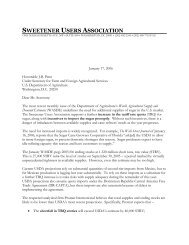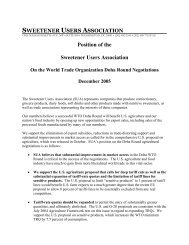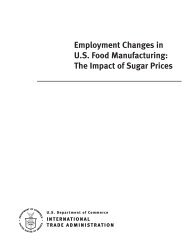Carbon Footprint in the Sweetener Sector - Sweetener Users ...
Carbon Footprint in the Sweetener Sector - Sweetener Users ...
Carbon Footprint in the Sweetener Sector - Sweetener Users ...
You also want an ePaper? Increase the reach of your titles
YUMPU automatically turns print PDFs into web optimized ePapers that Google loves.
Florida Crystals - Partner with <strong>the</strong> Environment<br />
<br />
<br />
<br />
<br />
<br />
We produce CLEAN ELECTRICITY. At Florida Crystals, we use our crops and urban<br />
wood waste as fuel to generate renewable electricity. We own and operate <strong>the</strong> largest<br />
renewable energy facility of its k<strong>in</strong>d <strong>in</strong> North America and one of <strong>the</strong> largest <strong>in</strong> <strong>the</strong> world.<br />
Efficient! ! Sugar cane ranks highest among all cultivated crops at captur<strong>in</strong>g solar<br />
energy <strong>in</strong> reusable form. Our renewable energy facility converts biomass (plant matter)<br />
to electricity. We recycle urban wood and vegetative waste and our leftover sugar cane<br />
fiber, called “bagasse” to produce clean, environmentally-friendly electricity that powers<br />
our sugar operations as well as 60,000 homes.<br />
Eco-friendly!<br />
Because we use local biomass as fuel, our facility elim<strong>in</strong>ates <strong>the</strong> e need for<br />
one million barrels of foreign oil per year. By reduc<strong>in</strong>g <strong>the</strong> use of harmful fossil fuels, we<br />
cut greenhouse gas emissions by hundreds of thousands of tons each year, help<strong>in</strong>g to<br />
reduce global warm<strong>in</strong>g.<br />
Conservation! Each year, we divert 900,000 tons of wood waste from landfills and a<br />
convert this o<strong>the</strong>rwise worthless waste to a valuable product, clean electricity. In do<strong>in</strong>g<br />
so, we conserve valuable landfill space -- 3.5 million cubic yards per year -- <strong>in</strong> urban<br />
communities.<br />
Local Economy! The cost of fuel accounts for 85% of <strong>the</strong> money spent by most power<br />
facilities. S<strong>in</strong>ce our fuel consists of locally grown and harvested sugar cane e fiber and<br />
locally collected recycled wood waste, we <strong>in</strong>vest that money <strong>in</strong> Florida. F<br />
Conversely, most<br />
fossil-fueled fueled power facilities send most of <strong>the</strong>ir money out of <strong>the</strong> state e or out of <strong>the</strong><br />
country.


